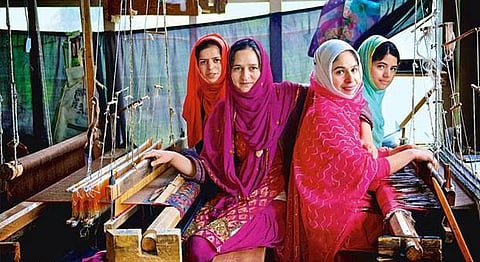
- HOMEGROWN WORLD
- #HGCREATORS
- #HGEXPLORE
- #HGVOICES
- #HGSHOP
- CAREERS
- ABOUT US
- CONTACT US

With only 2,000 craftsmen who truly know the craft left, Kani Shawls are an exquisite and expensive piece of clothing that originated from and is confined to the Kanihama area of Kashmir. In fact, Kani Shawls made outside of Kanihama cannot be legally sold as Kani.
The making of a Kani is a long and tedious process that can take anywhere from six months to a year and more. Apart from the shawl’s namesake being its place of origin, Kani also means ‘a small, wooden oblong spool’, which is what the shawls are made with. Like Pashmina, Kani is also made on a handloom. A needle made from the cane of wood is used and is woven thread by thread based on a talim or pattern that guides the craftsmen on the number of threads needed to cover one coloured weft. It takes at least 5-7 days to a design that isn’t much more than an inch. The amount of work that it takes to produce a pure Kani shawl justifies its insanely-high price. The price of a Kani can vary from anywhere between 40,000 to 2.5 lakh rupees.
Food to its price and exotic nature, Kani has always been a symbol of luxury. From the Mughal emperors to the Sikh Maharajas, they have been a prized possession in every household. Even so in museums like the Victoria and Albert Museum, the Metropolitan Museum of Art and more.
Of course, Kani is indigenous to Kashmir and an indispensable craft of India, however, with the development of modern technology and Kani Shawls being developed on machines, the market is going downhill. Fake Kani Shawls are being sold at throwaway prices putting the Kashmiri heritage at risk. Of course, a true connoisseur would know the difference between a handwoven Kani and one that is made on the machine. In 2010, Kani Shawls were provided Geographical Indication (GI) status. Microchips are inserted into authentic shawls to legally prohibit people from selling the drapes made at other places under the same name.
In 1981, only one atelier that wove Kani Shawls was left. Despite a short phase of revival, Kani stands on the brink of extinction again with only a few craftsmen left who know the craft as it was passed on to them by the forefathers. Nevertheless, with the massive contribution of 150 crores that the Kani industry makes of the shawl industry, we can stay hopeful that the craft will firmly establish itself in the market yet again.
If you enjoyed reading this article, we suggest you also read:
